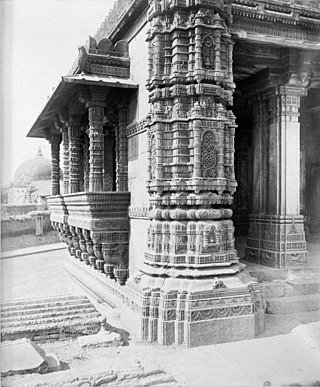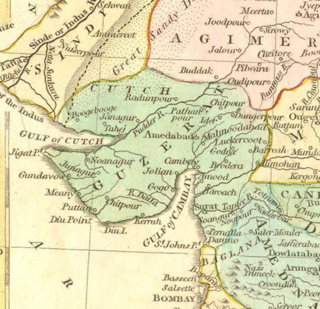
Mandu or Mandavgad is an ancient city in the present-day Mandav area of the Dhar district. It is located in the Malwa and Nimar region of western Madhya Pradesh, India, at 35 km from Dhar city. In the 11th century, Mandu was the sub division of the Tarangagadh or Taranga kingdom. This fortress town on a rocky outcrop about 100 km (62 mi) from Indore is celebrated for its architecture.
Ahmedabad is the largest city in the state of Gujarat. It is located in western India on the banks of the River Sabarmati. The city served as political as well as economical capital of the region since its establishment. The earliest settlement can be recorded around the 12th century under Chaulukya dynasty rule. The present city was founded on 26 February 1411 and announced as the capital on 4 March 1411 by Ahmed Shah I of Gujarat Sultanate as a new capital. Under the rule of sultanate (1411–1511) the city prospered followed by decline (1511–1572) when the capital was transferred to Champaner. For next 135 years (1572–1707), the city renewed greatness under the early rulers of Mughal Empire. The city suffered due to political instability (1707–1817) under late Mughal rulers followed by joint rule between Maratha and Mughal. The city further suffered following joint Maratha rule. The city again progressed when politically stabilized when British East India Company established the rule in the city (1818–1857). The city further renewed growth when it gain political freedom by establishment of municipality and opening of railway under British crown rule (1857–1947). Following arrival of Mahatma Gandhi in 1915, the city became centre stage of Indian independence movement. Many activists like Sardar Patel served the municipality of the city before taking part in the movement. After independence, the city was a part of Bombay state. When Gujarat was carved out in 1960, it again became the capital of the state until establishment of Gandhinagar in 1965. Ahmedabad is also the cultural and economical centre of Gujarat and the seventh largest city of India.
Ghogha is a census town in Bhavnagar district in the state of Gujarat, India. It is situated on the mid-western bank of the Gulf of Khambhat. It was an important historical commercial port on the Arabian Sea until the development of nearby Bhavnagar in the nineteenth century.
Shahibaug is one of the prominent neighborhoods of the city of Ahmedabad. It is primarily inhabited by the Marwadi and Jain communities, and is considered one of the wealthiest locales of Ahmedabad. The various food joints in the locality are famous throughout the city, particularly the ones serving Rajasthani cuisine. Additionally, the Dudheshwar area of Shahibaug on the west is inhabited mostly by Muslims and migrants from other states.

The Gujarat Sultanate or Sultanate of Guzerat was a late medieval Islamic Indian kingdom in Western India, primarily in the present-day state of Gujarat. The kingdom was established in 1394 when Muzaffar Shah I, the Governor of Gujarat, declared independence from the Tughlaq dynasty of Delhi.
The Farooqi dynasty or the Farooq Shahi was the ruling dynasty of the Khandesh Sultanate from its inception in 1382 till its annexation by the Mughal emperor Akbar in 1601. The founder of the dynasty, Malik Ahmad participated in a rebellion against the Bahmani ruler Muhmmad Shah I in his early years. When he was compelled to flee from Deccan, he established in Thalner on the Tapti River. After receiving the grant of the fiefdoms of Thalner and Karanda from Firuz Shah Tughluq in 1370, he conquered the region around Thalner, which later became known as Khandesh. By 1382, he started ruling independently.
Shahpur is a notified area in Ahmedabad in the Indian state of Gujarat. Shahpur is a ward of Dariapur.
Shaikh Jamali Kamboh was a 16th-century Punjabi Muslim poet and Sufi of the Suhrawardiyya Order and pupil of Poet Jami and of Shaikh Sama'al-Din Kamboh'.

Rani Sipri's Mosque also known as Rani Sipri ni Masjid or Masjid-e-nagina, formerly known as Rani Asni's Mosque, is a medieval mosque in the walled city of Ahmedabad, Gujarat in India. This mosque was commissioned in 1514 by Queen Sipri, the Hindu wife of Mahmud Begada, a sultan who ruled Gujarat. It is also known as Masjid-e-Nagina because of the intricate jali carvings on its walls. In 2006–7, the Ahmedabad Municipal Corporation proposed demolishing part of the monument in order to expand a road.

Jama Masjid, also known as Jumah Mosque or Jami' Masjid, is a mosque in Ahmedabad, Gujarat, India. It was built in 1424 during the reign of Ahmad Shah I. The inscription on the central mihrab commemorates the inauguration of the mosque on the 1st Safar A.H. 827 or January 4, 1424 A.D. by Sultan Ahmad Shah I. The mosque lies in the old walled city, and it is situated outside Bhadra Fort area. The old walled city is divided into separate quarters or pols, and the Jami' Masjid is found on the Gandhi Road. Along the south side of the road, the mosque is a short distance beyond the Teen Darwaza or Tripolia Gate.

Dariya Khan's Tomb or Darya Khan's Dome or Ghummat is a medieval brick tomb in Shahibaug, Ahmedabad, India.

Shah-e-Alam's Tomb and Mosque, also known as Rasulabad Dargah or Shah Alam no Rozo, is a medieval mosque and tomb complex (Roza) in Shah Alam area of Ahmedabad, India.

Muzaffar Shah I, born Zafar Khan, was the founder of the Muzaffarid dynasty in Medieval India, reigning over the Gujarat Sultanate from 1391 to 1403 and again from 1404 to 1411.
Sarkhej was one of the 182 assembly seats of Gujarat's Vidhan Sabha, from 1975 until 2012. It was a largely urban seat representing there 1⁄15 of Ahmedabad. Its abolition, along with others and new replacement seats were drawn up in 2008, in readiness for the next election which proved to be in 2012.
Gujarat, a region in western India, fell under the Delhi Sultanate following repeated expeditions under Alauddin Khalji around the end of the 13th century. He conquered the Kingdom of Gujarat which had been under the rule of the Vaghela dynasty under Karna II and established Muslim rule in Gujarat. Soon the Tughluq dynasty came to power in Delhi whose emperor carried out expeditions to quell rebellion in Gujarat and established their firm control over the region by the end of the century. Following Timur's invasion of Delhi, the Delhi Sultanate weakened considerably so that the last Tughluq governor Zafar Khan declared himself independent in 1407 and formally established the Gujarat Sultanate.
Nasir-ud-Din Mahmud Shah III was a sultan of the Muzaffarid dynasty who reigned over the Gujarat Sultanate, a late medieval kingdom in India from 1537 to 1554. He had to battle frequently with his nobles who were interested in independence, especially Darya Khán and Imád-ul-Mulk. He was killed by one of his servants.

The Gujarat Subah was a province (subah) of the Mughal Empire, encompassing the Gujarat region. The region first fell under Mughal control in 1573, when the Mughal emperor Akbar defeated the Gujarat Sultanate under Muzaffar Shah III.
Shaikh Gyasuddin Habibuddin is an Indian politician. He was Member of the Gujarat Legislative Assembly from Shahpur Assembly constituency since 2007 to 2012 and the Dariapur Assembly constituency since 2012 to 2022. He is associated with the Indian National Congress.










